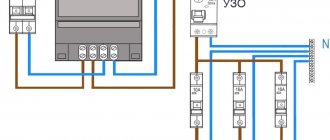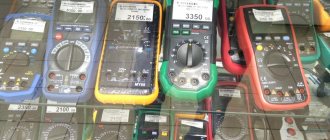The retail electricity market is a market where legal entities buy electricity at free prices, and the population at regulated prices.
As can be seen from the definition, the retail electricity market consists of two segments:
- Market of regulated prices for the population and
- Market of free prices for organizations and enterprises.
The price of electricity for the population is set by the service according to regional tariffs in each region individually.
Prices for legal entities are free.
In the retail electricity and capacity market, the price of electricity for legal entities can vary significantly depending on
- installed capacity,
- electricity price category,
- consumer connection voltage level,
- consumption schedule,
- electricity transmission tariffs,
- contractual terms and
- region.
Energy sales companies resell electricity purchased on the wholesale market to legal entities and enterprises at free prices.
At the same time, energy sales companies must take into account the rules of operation in the retail electricity and capacity market established in PP No. 442.
Decree of the Government of the Russian Federation dated May 4, 2012 No. 442 “Basic provisions for the functioning of retail electricity markets” is the main document that determines the operating procedure of the retail electricity and capacity market.
We will reduce your energy costs by 5% - 30%
Find out in detail
Next we will tell you:
- How does the retail electricity and capacity market work?
- How the price of electricity is formed in the retail electricity market
- Who is a guarantee supplier?
- What nuances should you pay attention to when interacting with a guaranteeing supplier?
- How independent energy sales companies work
- Tariffs of network companies
- Electricity producers
- What zones is the retail electricity and capacity market divided into?
Scheme of operation of the retail electricity market
In order to understand how the retail electricity market works, you need to start with the wholesale market.
On the wholesale market, electricity producers sell electricity to energy sales companies and large enterprises at market prices:
Next, energy sales companies resell electricity to end buyers - legal entities and the public.
Electricity price on the retail electricity market
The price of electricity for legal entities and enterprises consists of the following components:
If your final price is 5 rubles. / kWh, then you can easily understand how this price works out:
- About 50%-55% is the cost of electricity and capacity on the wholesale market - this is the share of electricity producers .
- 40%-45% is the cost of electricity transmission services. Network companies receive this portion .
- about 5%-9% .
- Less than 1% - the cost of other services - dispatch and coordination of the electricity market.
Regardless of what tariff you have (price category for electricity), four main players in the electricity market get your money:
- Guarantee supplier – sales company
- Network company
- Electricity Producer
- Network Administrator
Now let's look at why each of these participants in the retail electricity and power market is needed and how they affect the cost of electricity.
Guarantee supplier – sales company
Your interaction with the retail electricity market occurs through an energy sales company - a supplier of last resort.
A supplier of last resort is a company that “guarantees” the sale of electricity in your region.
The supplier of last resort is obliged to conclude an electricity sales agreement with each consumer who contacts him.
Each guaranteeing supplier has its own area of responsibility, determined by government agencies.
The supplier of last resort is obliged to enter into electricity sales agreements only with consumers located in its area of responsibility.
The supplier of last resort receives this practically monopoly right to sell electricity on the basis of a competition.
But the rules of the competition are such that practically the same guaranteed supplier constantly wins the competition and receives the exclusive right to sell electricity.
The main function of the supplier of last resort is to collect money from consumers in a timely manner and distribute it to other participants in the electricity market - grid companies and electricity producers.
If a supplier of last resort collects money poorly from consumers, it quickly falls into financial difficulties and goes down the drain - losing its monopoly position.
Another energy sales company is appointed in its place.
Now let's see how much and what the guaranteeing supplier earns and what nuances you need to pay attention to.
Amount of the guarantee supplier's sales premium
A guaranteed supplier earns from a sales premium, which is set by the service according to the tariffs of your region.
According to Decree of the Government of the Russian Federation No. 877 of November 4, 2011, the sales markup is the only official source of income for the guaranteeing supplier.
The sales markup includes the costs of the guaranteeing supplier
- for servicing consumers of electrical energy and
- to service bank loans aimed at bridging cash gaps.
As a rule, the sales markup ranges from 5% to 10% of the final cost of electricity.
Sales premiums are different in each region, since the number of consumers and the volume of their consumption differs from region to region.
As a rule, the smaller the region and the fewer consumers there are, the higher the sales premium.
We will reduce your energy costs by 5% - 30%
Find out in detail
You can find out the size of the sales premium on the website of your guaranteeing supplier in the section for legal entities.
The sales premium changes every year, and sometimes every six months.
Important nuance:
The sales markup of the supplier of last resort depends on the maximum power of the consumer. The higher the maximum power, the lower the sales premium.
What is maximum power and how it is calculated can be found here.
- If the maximum power of your organization is less than 670 kW, you have the maximum amount of sales allowance.
- If the maximum power of your organization is from 670 kW to 10 MW, your sales premium should be approximately 2 times lower.
- The lowest sales premium is for enterprises whose maximum capacity is more than 10 MW.
In order to check whether you are paying correctly, you need to check the amount of the sales surcharge in your electricity bill with the data published on the website of the guaranteeing supplier.
There are cases when these amounts do not “beat”.
And even more often, there are cases when there are several contracts with one consumer, in each of which only part of the maximum power is indicated.
Accordingly, the maximum power of the consumer is divided into 2 or 3 parts.
The consumer will be placed in a lower category and pay the maximum sales premium.
Real voltage measurement examples
The simplest example of measuring voltage at home is a AA battery. In it you need to attach the black probe to the “–” terminal and the red one to the “+” terminal, set the switch position to 2 V DC voltage.
Rice. 4. Example of measuring voltage on a battery
If the readings for a 1.5 V battery are in the range from 1.6 to 1.2 V, then such a power source is considered suitable for all equipment; if the values reduce to 1 - 0.7 V, pulsed devices will be started from the battery, for example, a watch. If the voltmeter shows 0.6 V or less, the discharge has reached a critical value.
When measuring the potential difference in a household network, you should touch the contacts of the socket with the probes. Since the insulated part of the probe has a restrictive ring behind which there is a long rod, you can safely reach into the outlet without the risk of touching live parts. Deviations from the nominal value by 10% are considered acceptable, that is, from 198 to 142 V.
You can also measure the potential difference at the output of a car battery or at another element of the electrical wiring circuit. To do this, the black probe of the multimeter is installed on the “–” terminal of the battery, and the red one on the “+” terminal.
If the battery is charged, then the voltmeter readings should be in the range from 12 to 14 V, but there are models with a large spread. This measurement allows you to diagnose various causes of problems.
Voltage level
The voltage level at which the consumer pays plays an even more important role than the maximum power.
The tariff voltage level is the voltage at which the consumer is connected to the external network.
There are 4 tariff voltage levels:
- High voltage (HV) - 110 kV and above
- Medium voltage 1 (CH1) - 35 kV
- Medium voltage 2 (CH2) - from 1 to 20 kV
- Low voltage (LV) - 0.4 kV
Tariffs for electricity transmission services are set in accordance with the tariff voltage level.
The higher the voltage level, the lower the cost of electricity transmission services.
Important nuance:
For payments for transmission services, the highest voltage level of the substation to which the consumer is connected is accepted.
For example, a consumer is connected to a 35/6 kV substation.
In this case, the tariff connection level should be 35 kV.
If the consumer pays for transmission services at a voltage level of 6 kV, then the cost of transmission services will be 1.5 - 2 times more expensive.
Transmission services account for approximately 40%-50% of the cost of electricity.
Reducing the cost of transmission services can result in very significant energy savings.
In order to make sure that you are paying the correct tariff voltage, you need to:
- Find the voltage level indicated in the statement of delineation of balance sheet ownership.
- Find the voltage level specified in the electricity supply contract.
- Make sure that the voltage levels in both documents match.
If the voltage levels do not match, you must immediately contact the supplier of last resort to amend the electricity supply contract.
It is worth noting that if you paid for electricity transmission services at a higher tariff due to an incorrectly specified voltage level, it will be extremely difficult to compensate for these losses.
Analytics Publications
(Decision of the Supreme Court of the Russian Federation dated February 1, 2016 in case No. A19-15605/2013)
One of the most expected results of the abolition of the Supreme Arbitration Court of the Russian Federation (SAC RF) is the revision by the Supreme Court of the Russian Federation (SC RF) of legal positions previously expressed in the process of considering specific cases.
In the electric power industry, the approach of the Supreme Arbitration Court of the Russian Federation, applied in case No. A40-85382/06-68-664[1], is often criticized, according to which the voltage level is a technical parameter and can be agreed upon by the parties without taking into account the actual conditions of connection. The applicability of this approach should also be assessed ambiguously in the case of indirect connection of consumer power receiving devices through electrical energy production facilities.
Relatively recently, the Supreme Court of the Russian Federation advocated a revision of this practice when considering case No. A19-15605/2013. Let us dwell in more detail on the actual circumstances of the case and the legal approaches of the RF Armed Forces.
Limited Liability Company "Technopark" (hereinafter referred to as the Company, Consumer) filed a claim with the Arbitration Court of the Irkutsk Region to recover from the Limited Liability Company "Irkutsk Energy Sales Irkutsk Electric Grid Mirror" the principle of choosing a tariff in the relationship "consumer - guaranteeing supplier" and "guarantee supplier - grid organization" also indicates that the rule regarding voltage level established by paragraph 55 of Methodological Instructions No. 20-e/2 applies to the listed entities of the retail electricity market, the calculations between which include services for the transmission of electrical energy.
3. The obligation to submit documents for the formation of prices (tariffs) is assigned to regulated organizations that, by the nature of their professional activities, have information that affects the procedure for payment for the purchased resource and services provided; the negative consequences of providing information that does not comply with regulations in relation to a consumer who does not participate in the formation of tariffs should not be assigned to such a consumer[9].
Consequently, the Supreme Court of the Russian Federation justified the inapplicability of the legal position set out in the Resolution of the Presidium of the Supreme Arbitration Court of the Russian Federation dated May 29, 2007 No. 16260/06 in case No. A40-85382/06-68-664 by the presence of contradictions between regulatory regulation and judicial assessment of the possibility of agreeing on the voltage level when concluding a contract energy supply.
Based on the results of the consideration of the case, the judicial acts of the lower courts were canceled, and the case was sent for a new trial to the arbitration court of first instance.
Thus, the definition in question by the RF Supreme Court changes the previously adopted approach of the courts, according to which the voltage level can be agreed upon by the parties even in the case of indirect connection through an electrical energy production facility.
It is worth noting that, in fact, the Supreme Court correctly resolved the conflict between regulatory regulation and the legal position of the Supreme Arbitration Court of the Russian Federation. This result, of course, indicates that at the moment the erroneous positions of the Supreme Arbitration Court are not binding on arbitration courts.
We emphasize that the legal position set out in the ruling of the Supreme Court of the Russian Federation dated 01.02.2016 in case No. A19-15605/2013, when used by consumers in the practice of considering similar cases, will have a positive impact on the outcome of the case and can also be used in the following manner: pre-trial settlement of disputes with network organizations and guaranteeing suppliers.
[1] Resolution of the Presidium of the Supreme Arbitration Court of the Russian Federation dated May 29, 2007 No. 16260/06 in case No. A40-85382/06-68-664.
[2] Thus, in this case there is a direct connection of the Consumer’s energy receiving devices to the generation facility.
[3] Article 6 of the Federal Law of March 26, 2003 No. 36-FZ “On the peculiarities of the functioning of the electric power industry and on introducing amendments to certain legislative acts of the Russian Federation and recognizing as invalid some legislative acts of the Russian Federation in connection with the adoption of the Federal Law “On Electric Power Industry”.
[4] Clause 6 of paragraph 3 of the Rules for non-discriminatory access to services for the transmission of electrical energy and the provision of these services, approved. Decree of the Government of the Russian Federation dated December 27, 2004 No. 861.
[5] Article 23 of the Federal Law of March 26, 2003 No. 35-FZ “On Electric Power Industry”.
[6] Order of the Federal Tariff Service of Russia dated 06.08.2004 No. 20-e/2 “On approval of the Methodological Instructions for calculating regulated tariffs and prices for electric (thermal) energy in the retail (consumer) market” paragraph 44.
[7] Order of the Federal Tariff Service of Russia dated August 6, 2004 No. 20-e/2 “On approval of the Methodological Instructions for calculating regulated tariffs and prices for electric (heat) energy in the retail (consumer) market.”
[8] Clause 55 of paragraph 2 of the Order of the Federal Tariff Service of Russia dated August 6, 2004 No. 20-e/2 “On approval of the Methodological Instructions for calculating regulated tariffs and prices for electric (thermal) energy in the retail (consumer) market.”
[9] Decree of the Government of the Russian Federation dated December 29, 2011 No. 1178 “On pricing in the field of regulated prices (tariffs) in the electric power industry” (together with the “Fundamentals of pricing in the field of regulated prices (tariffs) in the electric power industry”, “Rules of state regulation (revision, application ) prices (tariffs) in the electric power industry").
The right price category for electricity
Choosing the right electricity price point can significantly reduce your energy costs.
There are six price categories in total.
When concluding an energy supply contract with a guaranteeing supplier, if you have not chosen anything, you will automatically be
- first price if your connected power is less than 670 kW and
- into the third price category if your connected power is more than 670 kW.
These price categories are not always optimal for your organization.
The guaranteeing supplier does not care what price category you pay; his profit does not depend on it.
Choosing a price category is the responsibility of the consumer.
Brief description of each price category:
In the 1st category consumer
- pays for consumption according to the meter, and
- the cost of electricity, capacity and transmission services are included in a single tariff.
The first price category may be beneficial for small consumers who work the day shift.
In the 2nd price category, the cost of electricity, capacity and transmission services are also included in the tariff, but this tariff varies by day zone:
- during the day - expensive
- at night - cheap.
The second price category is suitable for organizations that work mainly on night shifts.
In the 3rd price category, the consumer pays separately for consumed electricity, power and transmission services.
As a rule, the cost of electricity in the third price category is cheaper than in the first.
The third price category is suitable for organizations that work one shift.
In the 4th price category, the consumer pays separately for consumed electricity, capacity and a two-rate tariff for transmission services.
The fourth price category is ideal for organizations with a 24-hour and stable work schedule.
The 5th and 6th price categories are the same 3rd and 4th, with only one difference:
In the fifth and sixth price categories, the consumer is required to plan hourly electricity consumption a day in advance.
For deviations from the plan, you have to pay.
If the consumer falls into the plan, the price for the 5th and 6th categories is 5% -7% lower than for the 3rd and 4th.
The fifth and sixth electricity categories are only suitable for organizations that can plan well.
Here we describe in detail how to correctly calculate and choose the price category of electricity.
In addition to choosing a price category, to reduce the cost of electricity, large consumers have the opportunity to switch from a supplier of last resort to an independent energy sales company.
How independent energy sales companies work and why switching to them can be profitable will be discussed in the next section.
Load switches type VNR. Design features and principle of operation.
In addition to load switches of the VN type, load switches of the VNR-10/400-10z type are also widely used in the CIS countries.
Design of load switch type VNR-10/400-10z
Six support insulators 2 are installed on the welded frame 1, while the contacts 3 with the holders of the main knives 4 are fixed on the lower insulators, and the main 6 and arc-extinguishing contacts, which are closed by arc-extinguishing devices, are fixed on the upper insulators. Using lever 8 and insulating rod 7, movement is transmitted from the switch shaft to the knives. To ensure the required shutdown speed, special springs 13 and shock-absorbing rubber washers 14 are mounted on the circuit breaker. Stationary grounding knives 10 are connected to the circuit breaker frame by flexible connections 9 and are driven by the shaft 11 of the grounding device.
To turn on the load switch, the handle of the drive lever is moved from bottom to top, while shaft 15 rotates and, using insulating rods, turns on the contact knives. To disconnect the switch, the handle of the drive lever is moved from top to bottom or remotely from the button with making contacts, while the shaft rotates under the action of the trip springs and turns off the switch.
Load switch type VNR-10/400-10z a) general view of the load switch; b) section of the arc chute; c, d) circuit breaker layout 1 - arc-extinguishing chamber: 2, 9 - fixed and movable working contacts; 3, 5 — levers of the load switch shaft and grounding knives; 4 - spring; 6 — shaft of grounding knives; 7 — grounding knives; 8 - flexible connection; 10, 12 - fixed and movable arc extinguishing contacts; 11 — organic glass insert; 13, 17 — drive rods of the load switch and grounding knives; 14, 16 — drives of the load switch and grounding knives: 15 — PKT fuses; 18 — half frame; 19 — frame
Independent energy sales company
Independent energy sales companies buy electricity on the wholesale market and resell it on the retail electricity market at free prices.
The pricing of independent energy sales companies is not regulated by the state, so they can set any prices for electricity.
In order to attract customers, energy sales companies offer prices for electricity lower than those of guaranteed suppliers.
Only large enterprises with an installed capacity of more than 750 kW can switch to service from an independent energy sales company.
In addition to the limitation on installed capacity, the enterprise must install an ASKUE system that meets the requirements of the wholesale market.
Installing an ASKUE system and meeting the requirements of the wholesale electricity market is not a cheap pleasure and can easily cost 2 - 3 million rubles.
Due to the above restrictions and the high cost of ASKUE, only large enterprises with high electricity consumption can switch to service from an independent energy sales company and thus reduce the cost of electricity.
Network company
You, the consumer of electricity, cannot influence the activities of the network organization.
However, since about 40% of the cost of electricity is the cost of transmission services, it is necessary to look at the activities and functions of network organizations.
A network organization is engaged in the transmission of electrical energy through its networks. The main function of a network company is to maintain electrical networks.
The tariff for the services of network organizations is set by the service according to the tariffs of your region.
An important point: the tariff for electricity transmission services can be single-rate or two-rate.
As a rule, a one-rate tariff is suitable for organizations with an unstable workload schedule, for example, working in one shift or many orders / few orders.
The two-part tariff is intended for organizations with a linear load schedule.
Autogas type load switch VNP-M1-10/630-20.
Load switch type VNP-M1-10/630-20
Load switches of type VNP-M1-10/630-20 are produced by the Nalchik High-Voltage Equipment Plant (Nalchik, Russia). Having undergone modernization, switching off the load has become safe to use. Intended for operation in cabinets of complete switchgear (KRU), in complete transformer substations (KTS), as well as in cells of stationary one-way and two-way service chambers (KSO) with a voltage of 10 kV three-phase alternating current with a frequency of 50 and 60 Hz for networks with grounded or isolated neutral. The switch is equipped with a built-in hand-wound spring drive, which is designed for both local and remote control.
Source: forca.ru
37156
Bookmarks
Comment 1
Latest publications
Crosstech Solutions Group held a business breakfast with the participation of Jet Infosystems
Yesterday, at 21:00 16
The chief engineer of the Kalugaenergo branch held working meetings with the heads of the rural settlements of Petrishchevo and Alekino in the Tarussky district
Yesterday, at 14:55 19
Schneider Electric Introduces PowerLogic DVR Dynamic Voltage Compensator to Improve Power Quality and Reliability
February 8 at 00:24 27
Kalugaenergo received gratitude from the administration of the village of Betlitsa
February 7 at 11:25 32
Igor Makovsky visited the machine-building plant, part of the Rosatom State Corporation, to get acquainted with the installed industrial-class electricity storage system.
February 4 at 18:29 61
Customer technical support is a priority for ANTRAX Group of Companies
February 4 at 17:37 57
Udmurtenergo provided reliable power supply to the sports and recreation complex in the city of Votkinsk
February 4 at 16:59 98
Kurskenergo connected a large agricultural facility in the Kursk region to the networks
February 4 at 11:29 67
Schneider Electric expands digital renewable energy procurement capabilities globally with acquisition of Zeigo platform
February 4 at 10:45 41
Why is the premium segment of complex household equipment growing? Results of 2022
February 3 at 15:02 56
Comments 1
Electricity producers
The main players in the retail electricity market are, of course, electricity producers.
Electricity producers with an installed capacity of more than 25 MW are required to sell electricity and capacity on the wholesale electricity market.
Power producers with installed capacity of less than 25 MW sell electricity through the retail electricity and capacity market.
In some cases, the cost of electricity from small producers may be lower than from guaranteed suppliers.
Four price zones in Russia
The retail electricity and power market is divided into 4 price zones.
All of the above rules apply only to free price zones in Russia - these are the first and second price zones.
The first and second price zones include the overwhelming majority of Russian consumers - this is the European part of Russia, the Urals and Siberia.
Here's what it looks like on the map:
In price zones, prices for consumers on the retail electricity market are free.
In the non-price zone and in the isolated zone, prices are set by the state.
It is worth recalling that the division into price (free) and non-price (regulated) zones applies only to legal entities.
The population always pays regulated prices set by the state.
We will reduce your energy costs by 5% - 30%
Load switches of VN and VNP types. Design features and principle of operation.
A VN-type load switch consists of the following structural units - a common frame 4, suspended on support insulators 5, on which arc-extinguishing chambers 3 are mounted with fixed contacts - main 2 and arc-extinguishing 12, moving contacts - main 9 and arc-extinguishing 7, a common drive shaft 6, connected to the poles of insulating rods 8.
Load switch type VN-16 for 6 and 10 kV, having a rated breaking current Inom = 400 A and 200 A (in some cases - up to 800 A) and a breaking power of 4 and 3 MVA: a) general view; b) arc extinguishing device for longitudinal blast
The design of the arc-extinguishing chamber of the VN-16 type load switch includes two plastic cheeks 13, inside of which there are replaceable liners 10 made of plexiglass and forming a narrow slot 11 in which the arc-extinguishing contact moves. Switching “shutdown” is carried out by two shutdown springs 1, while an electric arc 14 is formed between the arc-extinguishing contacts, causing intense gas release from the walls of the liners and, accordingly, an increase in pressure in the chamber. The path for the gases to escape, namely through the gap between the contacts and the walls of the chamber, passes through the arc burning area, while the gases create longitudinal blowing and thereby extinguish the electric arc. The arcing chambers of the load break switch have a high degree of wear, i.e. designed for a large number of shutdown operations (without replacing the liner), for example, a current of 50 A can be turned off 300 times, a current of 100 A - 200 times, a current of 200 A - 75 times, and a current of 400 A - 4 times.
When turned off, the main working contacts open first, and then the arc extinguishing contacts; when turned on, this process occurs in reverse, while in the off state the moving contact forms a fairly large visible gap. Stationary grounding blades can be mounted on load switches, with mechanical interlocking to prevent erroneous actions to turn on the device.
To control the load switch of type VN-16, the use of a drive of type PRA-17 (manual automatic drive) is provided. This drive has a free release mechanism and a built-in electromagnet for remote shutdown of the switching device. The advantages of this drive are: simple and reliable design, convenient operation, but the disadvantage is the inability to turn on the load switch remotely and automatically. This type of drive can be used with other types of load switches, such as VNP-16, VNP-17, VNP-11, etc.
To solve the problem of impossible switching on of the device remotely, electromagnetic or pneumatic drives are used, which are classified as direct-acting drives. The advantages are also simplicity of design and reliability in operation, but the disadvantage is dependence on a powerful source of operational direct current, because a lot of energy is consumed to carry out the switching operation.
In Russia, as well as in other CIS countries, in addition to the VN-16 type load switch, other types of load switches are quite successfully used - VN-10, VN-11, VNP-16, VNP-17. The design is a combination of a cutting-type internal disconnector with autogas arc-extinguishing chambers mounted on it, made of plexiglass.
These devices provide for switching on and off operations for load currents of 200-400 A, as well as for protection against short circuit currents. Therefore, to perform the assigned functions, the load switch is equipped with high-voltage quartz fuses (PC).
Autogas load switch type VN-10, with a manual drive for a rated voltage of 10 kV, with a rated current of 400 A and a thermal current of 10 kA 1 - main contact system; 2-arc extinguishing device; 3-system of arc extinguishing moving contacts
The principle of operation of the load switch type VN-10 is the same as that of the load switch type VN-16. The principle of arc extinguishing is carried out due to the gases formed due to the decomposition of the plexiglass liner. When opening the circuit breaker, the main contacts are opened first, then the arcing contacts, which are located in the arcing chamber. In this case, the electric arc acts on the walls of the liner, forming intense gas release. Due to the difficult exit of gases from the arc extinguishing device, the pressure in the chamber increases, which leads to rapid extinguishing of the arc.
The switch is mounted with a manual drive, which is equipped with a free release mechanism and a trip electromagnet. Thus, closing operations are carried out only manually, and opening operations are carried out manually and remotely using a tripping electromagnet, which is powered by an independent current source.
This type of switch is equipped with stationary grounding blades, which can be used to ground both the upper and lower output contacts, and it is also possible to install high-voltage fuses on the upper or lower side of the switch.











